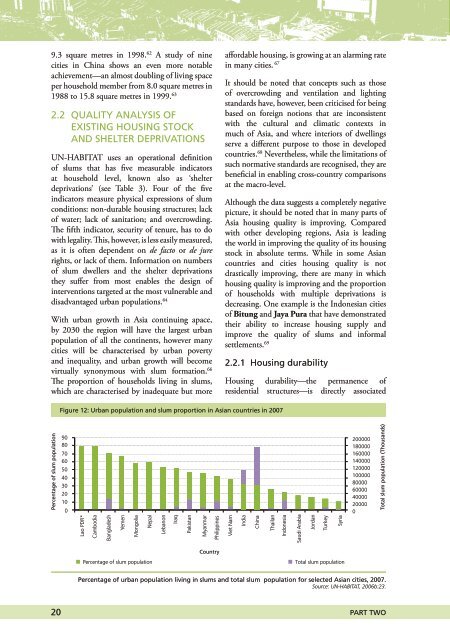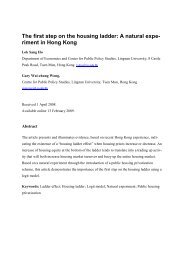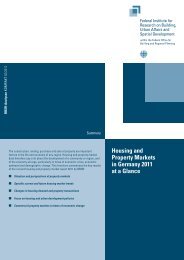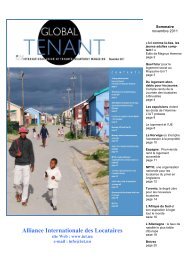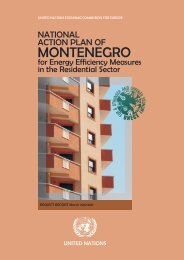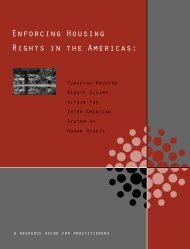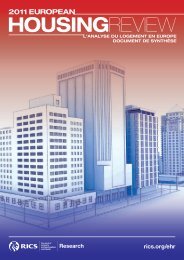9.3 square metres <strong>in</strong> 1998. 62 A study <strong>of</strong> n<strong>in</strong>ecities <strong>in</strong> Ch<strong>in</strong>a shows an even more notableachievement—an almost doubl<strong>in</strong>g <strong>of</strong> liv<strong>in</strong>g spaceper household member from 8.0 square metres <strong>in</strong>1988 to 15.8 square metres <strong>in</strong> 1999. 632.2 QUALITY ANALYSIS OFEXISTING HOUSING STOCKAND SHELTER DEPRIVATIONSUN-HABITAT uses an operational def<strong>in</strong>ition<strong>of</strong> slums that has five measurable <strong>in</strong>dicatorsat household level, known also as ‘shelterdeprivations’ (see Table 3). Four <strong>of</strong> the five<strong>in</strong>dicators measure physical expressions <strong>of</strong> slumconditions: non-durable <strong>hous<strong>in</strong>g</strong> structures; lack<strong>of</strong> water; lack <strong>of</strong> sanitation; <strong>and</strong> overcrowd<strong>in</strong>g.The fifth <strong>in</strong>dicator, security <strong>of</strong> tenure, has to dowith legality. This, however, is less easily measured,as it is <strong>of</strong>ten dependent on de facto or de jurerights, or lack <strong>of</strong> them. Information on numbers<strong>of</strong> slum dwellers <strong>and</strong> the shelter deprivationsthey suffer from most enables the design <strong>of</strong><strong>in</strong>terventions targeted at the most vulnerable <strong>and</strong>disadvantaged urban populations. 64With urban growth <strong>in</strong> Asia cont<strong>in</strong>u<strong>in</strong>g apace,by 2030 the region will have the largest urbanpopulation <strong>of</strong> all the cont<strong>in</strong>ents, however manycities will be characterised by urban poverty<strong>and</strong> <strong>in</strong>equality, <strong>and</strong> urban growth will becomevirtually synonymous with slum formation. 66The proportion <strong>of</strong> households liv<strong>in</strong>g <strong>in</strong> slums,which are characterised by <strong>in</strong>adequate but more<strong>affordable</strong> <strong>hous<strong>in</strong>g</strong>, is grow<strong>in</strong>g at an alarm<strong>in</strong>g rate<strong>in</strong> many cities. 67It should be noted that concepts such as those<strong>of</strong> overcrowd<strong>in</strong>g <strong>and</strong> ventilation <strong>and</strong> light<strong>in</strong>gst<strong>and</strong>ards have, however, been criticised for be<strong>in</strong>gbased on foreign notions that are <strong>in</strong>consistentwith the cultural <strong>and</strong> climatic contexts <strong>in</strong>much <strong>of</strong> Asia, <strong>and</strong> where <strong>in</strong>teriors <strong>of</strong> dwell<strong>in</strong>gsserve a different purpose to those <strong>in</strong> developedcountries. 68 Nevertheless, while the limitations <strong>of</strong>such normative st<strong>and</strong>ards are recognised, they arebeneficial <strong>in</strong> enabl<strong>in</strong>g cross-country comparisonsat the macro-level.Although the data suggests a completely negativepicture, it should be noted that <strong>in</strong> many parts <strong>of</strong>Asia <strong>hous<strong>in</strong>g</strong> quality is improv<strong>in</strong>g. Comparedwith other develop<strong>in</strong>g regions, Asia is lead<strong>in</strong>gthe world <strong>in</strong> improv<strong>in</strong>g the quality <strong>of</strong> its <strong>hous<strong>in</strong>g</strong>stock <strong>in</strong> absolute terms. While <strong>in</strong> some Asiancountries <strong>and</strong> cities <strong>hous<strong>in</strong>g</strong> quality is notdrastically improv<strong>in</strong>g, there are many <strong>in</strong> which<strong>hous<strong>in</strong>g</strong> quality is improv<strong>in</strong>g <strong>and</strong> the proportion<strong>of</strong> households with multiple deprivations isdecreas<strong>in</strong>g. One example is the Indonesian cities<strong>of</strong> Bitung <strong>and</strong> Jaya Pura that have demonstratedtheir ability to <strong>in</strong>crease <strong>hous<strong>in</strong>g</strong> supply <strong>and</strong>improve the quality <strong>of</strong> slums <strong>and</strong> <strong>in</strong>formalsettlements. 692.2.1 Hous<strong>in</strong>g durabilityHous<strong>in</strong>g durability—the permanence <strong>of</strong>residential structures—is directly associatedFigure 12: Urban population <strong>and</strong> slum proportion <strong>in</strong> Asian countries <strong>in</strong> 2007Percentage <strong>of</strong> slum population9080706050403020100200000180000160000140000120000100000800006000040000200000Lao PDR*CambodiaBangladeshYemenTotal slum population (Thous<strong>and</strong>s)MongoliaNepalLebanonIraqPakistanMyanmarPhilipp<strong>in</strong>esViet NamIndiaCh<strong>in</strong>aThailanIndonesiaSaudi ArabiaJordanTurkeySyriaCountryPercentage <strong>of</strong> slum populationTotal slum populationPercentage <strong>of</strong> urban population liv<strong>in</strong>g <strong>in</strong> slums <strong>and</strong> total slum population for selected Asian cities, 2007.Source: UN-HABITAT, 2006b:23.20PART two
Table 4: Hous<strong>in</strong>g conditions among urban populations <strong>in</strong> Asia, 2003Percentage <strong>of</strong> population hav<strong>in</strong>g:Urbanpopulation(000s)F<strong>in</strong>ished floormaterialsSufficientliv<strong>in</strong>g spaceAccess toimproveddr<strong>in</strong>k<strong>in</strong>gwaterAccess toimprovedsanitationEastern Asia 564,871 98.4 91.5 92.5 69.4Southern Asia 448,738 84.8 65.0 94.3 67.0South-Eastern Asia 228,636 98.6 73.1 91.0 80.0Western Asia 124,370 96.4 91.1 95.1 94.9Source: UN-HABITAT (2006b).with accessibility <strong>and</strong> affordability. Accord<strong>in</strong>g toUN-HABITAT estimates, <strong>in</strong> 2003 Asia had thelargest proportion (73 per cent) <strong>of</strong> urban dwellers<strong>in</strong> the develop<strong>in</strong>g world liv<strong>in</strong>g <strong>in</strong> non-permanent<strong>hous<strong>in</strong>g</strong>. Over 50 per cent <strong>of</strong> this populationlived <strong>in</strong> Southern Asia <strong>and</strong> 11 per cent <strong>in</strong> South-East Asia. In Bangladesh, Nepal <strong>and</strong> Pakistan,one <strong>in</strong> three urban dwellers lack durable <strong>hous<strong>in</strong>g</strong>,while <strong>in</strong> India this figure is one <strong>in</strong> ten (equat<strong>in</strong>gto around 28 million people). In Asia, <strong>in</strong> general,there does not appear to have been as muchprogress <strong>in</strong> improv<strong>in</strong>g <strong>hous<strong>in</strong>g</strong> durability as <strong>in</strong>other develop<strong>in</strong>g regions. However, as notedthere have been significant improvements <strong>in</strong>several secondary cities <strong>in</strong> Indonesia. 70Global figures on <strong>hous<strong>in</strong>g</strong> durability are basedprimarily on permanence <strong>of</strong> <strong>in</strong>dividual structures,rather than compliance with build<strong>in</strong>g codes orlocation. Most only take <strong>in</strong>to account the nature<strong>of</strong> the floor material as few countries collect<strong>in</strong>formation on wall <strong>and</strong> ro<strong>of</strong> materials. They are,therefore, grossly underestimated. Indeed, if themeasures <strong>of</strong> durability were to <strong>in</strong>clude quality <strong>of</strong>ro<strong>of</strong> <strong>and</strong> wall materials, the figures for durable<strong>hous<strong>in</strong>g</strong> <strong>in</strong> the stock for many countries woulddecrease significantly. For example, when only thefloor criterion was used <strong>in</strong> Indonesia, 84 per cent<strong>of</strong> dwell<strong>in</strong>gs were considered durable as opposedto 70 per cent when the three components weretaken <strong>in</strong>to account. 712.2.2 Sufficient liv<strong>in</strong>g areaOvercrowd<strong>in</strong>g (lack <strong>of</strong> sufficient liv<strong>in</strong>g area)is a manifestation <strong>of</strong> <strong>hous<strong>in</strong>g</strong> <strong>in</strong>equality thatresults from a comb<strong>in</strong>ation <strong>of</strong> factors, the mostprom<strong>in</strong>ent <strong>of</strong> which are perhaps <strong>in</strong>sufficient<strong>hous<strong>in</strong>g</strong> stock <strong>and</strong> lack <strong>of</strong> <strong>affordable</strong> <strong>hous<strong>in</strong>g</strong>. It isalso argued to be a hidden form <strong>of</strong> homelessnessas many people with nowhere to live areaccommodated by relatives or friends, whichresults <strong>in</strong> overcrowd<strong>in</strong>g.In 2003, approximately 20 per cent <strong>of</strong> urb<strong>and</strong>wellers <strong>in</strong> develop<strong>in</strong>g countries lived <strong>in</strong> housesthat lacked sufficient liv<strong>in</strong>g area (with three ormore people shar<strong>in</strong>g a room). Two-thirds <strong>of</strong> those<strong>in</strong> develop<strong>in</strong>g countries liv<strong>in</strong>g <strong>in</strong> overcrowdedconditions reside <strong>in</strong> Asia, with half <strong>of</strong> thisnumber to be found <strong>in</strong> Southern Asia. 72 One<strong>in</strong> three urban dwellers <strong>in</strong> Southern Asia lackssufficient liv<strong>in</strong>g area: the highest prevalence <strong>of</strong>overcrowd<strong>in</strong>g <strong>in</strong> the develop<strong>in</strong>g world.ALTHOUGH THEDATA SUGGESTS ACOMPLETELY NEGATIVEPICTURE, IN MANYPARTS OF ASIA HOUSINGQUALITY IS IMPROVING.COMPARED WITH OTHERDEVELOPING REGIONS, ASIA ISLEADING THE WORLD IN IMPROVINGTHE QUALITY OF ITS HOUSING STOCKIN ABSOLUTE TERMS.AFFORDABLE LAND <strong>and</strong> HOUSING IN Asia21
- Page 3: AFFORDABLE LANDAND HOUSING IN ASIAV
- Page 7 and 8: 3.2.1 HOUSING POLICY AND LEGISLATIV
- Page 13 and 14: LIST OF FIGURESFigure 1: A woman pr
- Page 15 and 16: LIST OF TABLESTable 1: Regional urb
- Page 17 and 18: 1PART oneIntroduction- affordableho
- Page 19 and 20: Figure 3: Regional urbanisation tre
- Page 24 and 25: Figure 7: High-rise multi-household
- Page 26 and 27: can be found throughout Asian citie
- Page 28 and 29: AFFORDABLEHOUSING ISBROADLY DEFINED
- Page 30 and 31: Figure 9: Slum housing in South Asi
- Page 32 and 33: The housingstock in manycountries i
- Page 34 and 35: 2. THE STATE OFAFFORDABLE LANDAND H
- Page 38 and 39: An analysis of sufficient living ar
- Page 40 and 41: POORER URBANHOUSEHOLDSIN ASIA SIMPL
- Page 42 and 43: THE FORMAL SECTORPlan Service Build
- Page 44 and 45: PART TWO ENDNOTES49 Nenova, T. (201
- Page 46 and 47: Over the lasttwo decadesmicrofinanc
- Page 48 and 49: 3. ADDRESSINGTHE CHALLENGE:AFFORDAB
- Page 50 and 51: HOUSING IS ACATALYST FORSOCIO-ECONO
- Page 52 and 53: lower- to middle-income groups. How
- Page 54 and 55: Grihayan Tahabil (Housing Fund) thr
- Page 56 and 57: provision, especially in countries
- Page 58 and 59: heritage, infrastructure and servic
- Page 60 and 61: market transactions. All units are
- Page 62 and 63: Boatu and Chengdu alone, 600,000 pe
- Page 64 and 65: have built an estimated 700,000 dwe
- Page 66 and 67: 3.2.7 The contribution of NGOsThe m
- Page 68 and 69: quantity and at an affordable cost,
- Page 70 and 71: OVER THE LASTTWO DECADESMICROFINANC
- Page 72 and 73: Table 7: Community savings groups i
- Page 74 and 75: RemittancesRemittances-money transf
- Page 76 and 77: PART THREE ENDNOTES101 UNCHS (1997a
- Page 78 and 79: Access toadequate andaffordablehous
- Page 80 and 81: 4. NOTABLE TRENDS,RECOMMENDATIONSAN
- Page 82 and 83: Overcoming discrimination against w
- Page 84 and 85: Affordable housing for plantation w
- Page 86 and 87:
opportunities to solve the underemp
- Page 88 and 89:
of other housing delivery systems t
- Page 90 and 91:
PART FOUR ENDNOTES201 UNCHS (1997b)
- Page 92 and 93:
76 PART FIVE
- Page 94 and 95:
AAcioly, C. Jr. (2008). Housing Str
- Page 96 and 97:
JJack, M. (2006). Urbanisation, sus
- Page 98 and 99:
Tipple, A. G. and A. Salim (1999).
- Page 100 and 101:
WWang, Y. P. (2004). Urban poverty,
- Page 102:
AFFORDABLE LANDAND HOUSING INASIAAf


